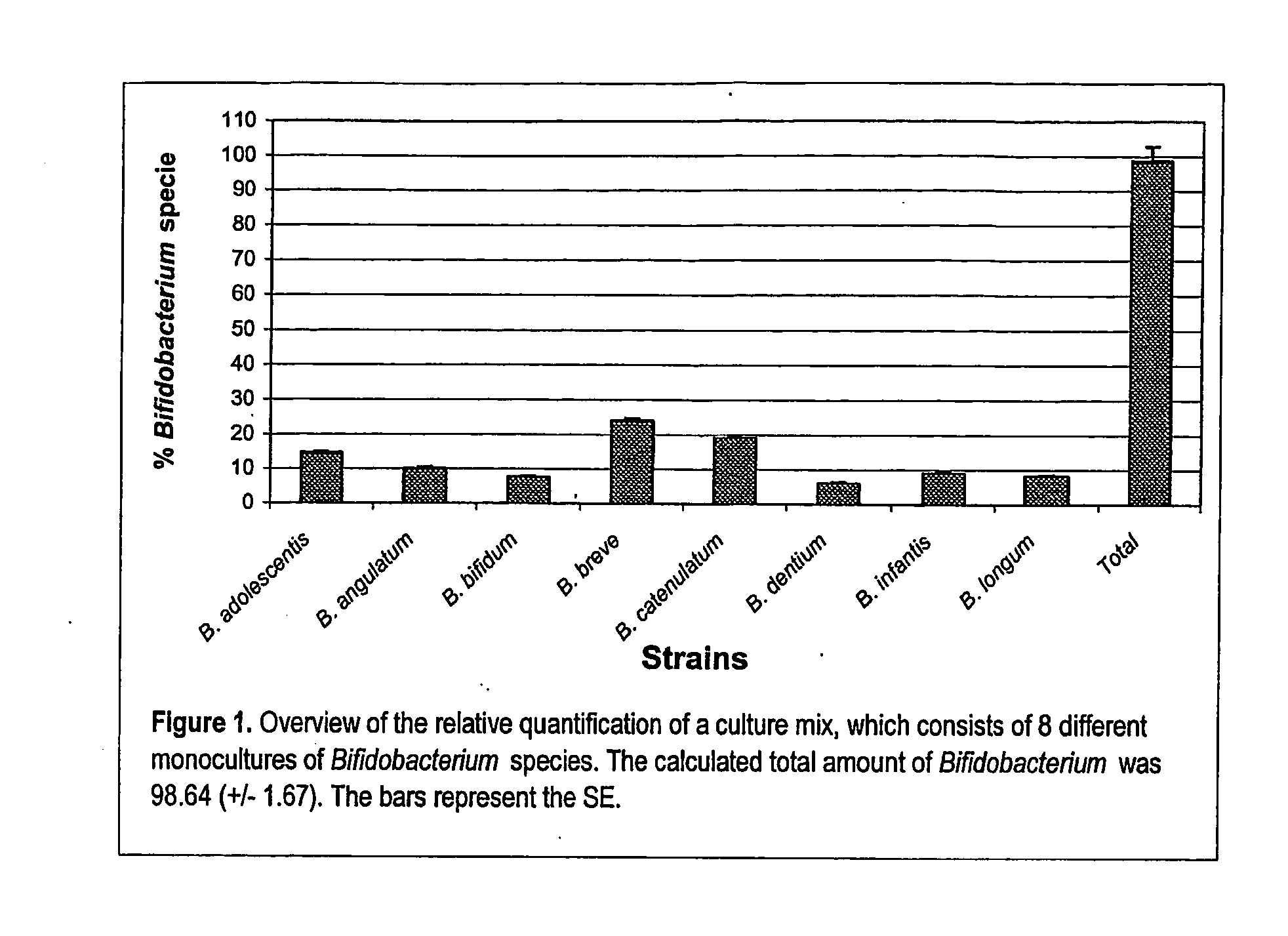Synbiotic Composition For Infants
a technology for infants and synbiotics, applied in the field of preparations, can solve the problems of deficiency of bifidobacterium /i>population in such prebiotic-fed infants, and achieve the effect of increasing the level of bifidobacterium
- Summary
- Abstract
- Description
- Claims
- Application Information
AI Technical Summary
Benefits of technology
Problems solved by technology
Method used
Image
Examples
example 1
Validation of the Developed Probes and Primers for Bifidobacteria
[0112] The bacterial strains used to validate the assays for the relative quantification of the different Bifidobacterium species are listed in Table 2.
TABLE 2Bacterial strains and origins used for the developmentof the 5′ nuclease assaysStrainOriginaBifidobacterium strainsB. adolescentisATCC 15703TATCC 15705B. angulatumDSM 20098TB. animalisATCC 25527TDSM 10140B. bifidumDSM 20456TNCIMB 8810B. boumATCC 27917TB. breveATCC 15700TDSM 20091LMG 11613B. catenulatumATCC 27539TATCC 27675B. dentiumATCC 27534TB. gallicumDSM 20093TB. gallinarumATCC 33777TB. infantisLMG 8811TB. inopinatumDSM 10107TB. longumATCC 15707TB. magnumATCC 27540TB. pseudocatenulatumDSM 20438TB. pseudolongumATCC 25526TB. suisATCC 27533TOther StrainsBacillus cereusATCC 11778Bacteroides fragilusLMG 10263TBrevibacterium caseiATCC 35513TClostridium difficileATCC 9689TEnterococcus feacalisDSM 20478TEscherichia coliATCC 35218Lactobacillus acidophilusATCC 4356TL...
example 2
[0118] The study was a double blind, placebo-controlled multi-center trial with two intervention groups. Fully formula fed infants, aged 28 to 90 days, were recruited from four hospitals in Germany. Infants were included in the study if they had a birth weight between 2600 and 4500 g, and were fully formula fed for at least four weeks before the start of the intervention period. Infants with congenital abnormalities, or with proven or suspected cow's milk allergy, infants derived from multiple births, infants that had received antibiotics less than two weeks before the start of the study, and infants that were fed any pro- or prebiotic formula less than a month before the start of the study, were excluded from the study. After enrollment, infants were randomly allocated to one of two treatment groups: a group receiving an infant formula supplemented with 0.8 g / 100 ml galacto-oligosaccharides and fructo-polysaccharides (GFSF-group) and a group receiving a standard infa...
example 3
Animal Experiments on Allergy
[0127] Specific pathogen free male BALB / c mice were obtained from Charles River (Maastricht, the Netherlands). Food and water was provided ad libituin and the mice were used when 6-9 weeks of age. All experiments were approved by the animal ethics committee of the University of Utrecht, The Netherlands.
[0128] Ovalbumin (grade V) and acetyl-β-methylcholine chloride (methacholine) were purchased from Sigma Chemical Co. (St. Louis, Mo., USA). Aluminum hydroxide (AlumImject) was purchased from Pierce (Rockford, Ill., USA).
[0129] Mice were sensitised by two i.p. injections with 10 μg ovalbumin adsorbed onto 2.25 mg aluminium hydroxide in 100 μl saline or saline alone on days 0 and 7. Mice were challenged on days 35, 38, and 41 by inhalation of ovalbumin aerosols in a plexiglass exposure chamber for 20 minutes. The aerosols were generated by nebulising an ovalbumin solution (10 mg / mi) in saline using a Pari LC Star nebulizer (Pari respiratory Equipment, Ric...
PUM
| Property | Measurement | Unit |
|---|---|---|
| wt % | aaaaa | aaaaa |
| wt % | aaaaa | aaaaa |
| wt % | aaaaa | aaaaa |
Abstract
Description
Claims
Application Information
 Login to View More
Login to View More - R&D
- Intellectual Property
- Life Sciences
- Materials
- Tech Scout
- Unparalleled Data Quality
- Higher Quality Content
- 60% Fewer Hallucinations
Browse by: Latest US Patents, China's latest patents, Technical Efficacy Thesaurus, Application Domain, Technology Topic, Popular Technical Reports.
© 2025 PatSnap. All rights reserved.Legal|Privacy policy|Modern Slavery Act Transparency Statement|Sitemap|About US| Contact US: help@patsnap.com


